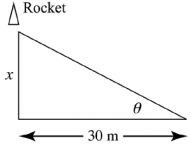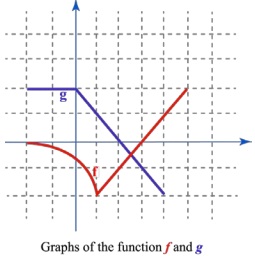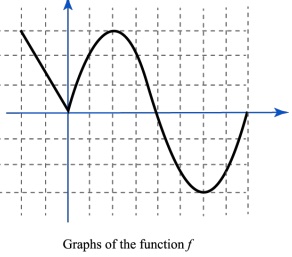Reference no: EM132429354
Assignment
Question 1. As shown in the figure below, a camera is mounted on a point 30 m from the base of a rocket launching pad. The rocket rises vertically when launched, and the camera's angle is continually adjusted to follow the base of the rocket.

a. Express the height x as a function of the elevation angle θ.
b. give the domain of the function in part a.
c. give the height of the rocket when the elevation angle is Π/3.
Question 2. Consider the graphs of the functions f and g shown in the figure below.

a. fill in the table below with the corresponding values of f and g.
|
x
|
-2
|
-1
|
0
|
1
|
2
|
3
|
4
|
5
|
|
f (x)
|
|
|
|
|
|
|
|
|
|
g(x)
|
|
|
|
|
|
|
|
|
b. Use the table in part a to evaluate each of the expressions listed below.
i. g o f (-2)
ii. g o f (1)
iii. g o f (4)
iv. f o g(0)
v. f o g(4)
vi. f o g(-1)
Question 3. Let f (x) = √(1 - 2x), g(x) = x/(x2 - 1). find the formulas for the functions listed below and specify their respective domains.
a. f/g
b. g o f
c. gf2
Question 4. Consider the graph of the function f shown below.

Apply the appropriate transformations and sketch the functions listed below. Aim for a neat, labeled graph.
a. f (x) = f (2x) - 1
b. g(x) = 1 - 2f (x)
Question 5. Indicate whether each of the limits listed below is well-defined. Explain your answer in each case.
a. limx→2 √(x2 - 4)
b. limx→∞cot((x2 + 1)/(x+3))
Question 6. Determine whether the evaluation of the limits given below are correct. If it is correct, explain why. If not, give the correct evaluation.
a. for x → -∞ we have √(x2 - x3)/x = (√(-x3)√1-1/x)/x, hence
= limx→-∞√(x2 - x3)/x = limx →-∞ √-x3√1-1/x)/x = limx →-∞ √(1 -1/x)√-x = ∞
b. limx →0 x2 sin(x - Π/2)/(1 - cos(3x)) = limx →0 x2 sin(x - Π/2) (1 + cos(3x))/((1 - cos(3x))(1 + cos(3x)))
= limx →0 x2 sin(x - Π/2) (1 + cos(3x))/(sin2(3x))
= limx→0 (x/sin(3x))2sin(x - Π / 2)(1 + cos(3x))
= limx→0 (x/sin(3x))2 limx→0 sin(x - Π / 2)limx→0 1 + cos(3x)
= 1/9 (-1)(1)
= - 1/9
Question 7. Evaluate each of the limits listed below. Justify your answers by identifying the results of Units 2 and 3 you apply in each case. If a limit does not exist, explain why.
a. limx →0 sin(Π - x)/√(x2 - x + 1)
b. limx→3 (x3 - 3x2 + 4x - 12)/(3x2 - 7 x - 6)
c. limx→∞ cos((Πx+1)(3 -x2)/x3-Π)
d. limx→∞ xsin(3x)/(x2 + 1)
e. limx+1+ sin(√x+1/(x2 -1))
f. limx →0+ √(x3+ x2)/(√(x+1) -1)
g. limx →0 sin2(3x)/(1 - cos(2x)
Question 8. Let
2/x if x < 0x
f (x) = √x+ cos(Π x) if 0 < x ≤ 5
x/(x-5) if x > 5
Evaluate the limits listed below. If a limit does not exist explain why.
a. lim f (x)
x →0-
b. lim f (x)
x →0+
c. lim f (x)
x →5-
d. lim f (x)
x →5+
e. lim f (x)
x →5
f. lim f (x)
x →∞
g. lim f (x)
x →-∞
Where is the function not continuous? Explain.
Question 9. give the graph of one and only one function which satisfies all the following conditions.
a. Domain of the function [-5,0) ∪(0,∞)
b. The function is continuous on its domain
c. f (-5) = f (5)
d. lim f (x) = 6
x →5
e. lim f (x) = ∞
x →0-
f. lim f (x) = 0
x →0+
g. lim f (x) = -∞
x →∞
Explain why the graph of a function which satisfies all these conditions must intercept the x-axis, meaning that there is at least one number c so that f (c) = 0.
Question 10. Prove each of the statements below using the formal definition of limits.
a. If lim f (x) = -∞ and c > 0, then lim c f (x) = -∞.
x →∞ x →∞
b. If lim g(x) = ∞ and g(x) ≤ f (x) for x → a, then lim f (x) = ∞.
x →a x →a